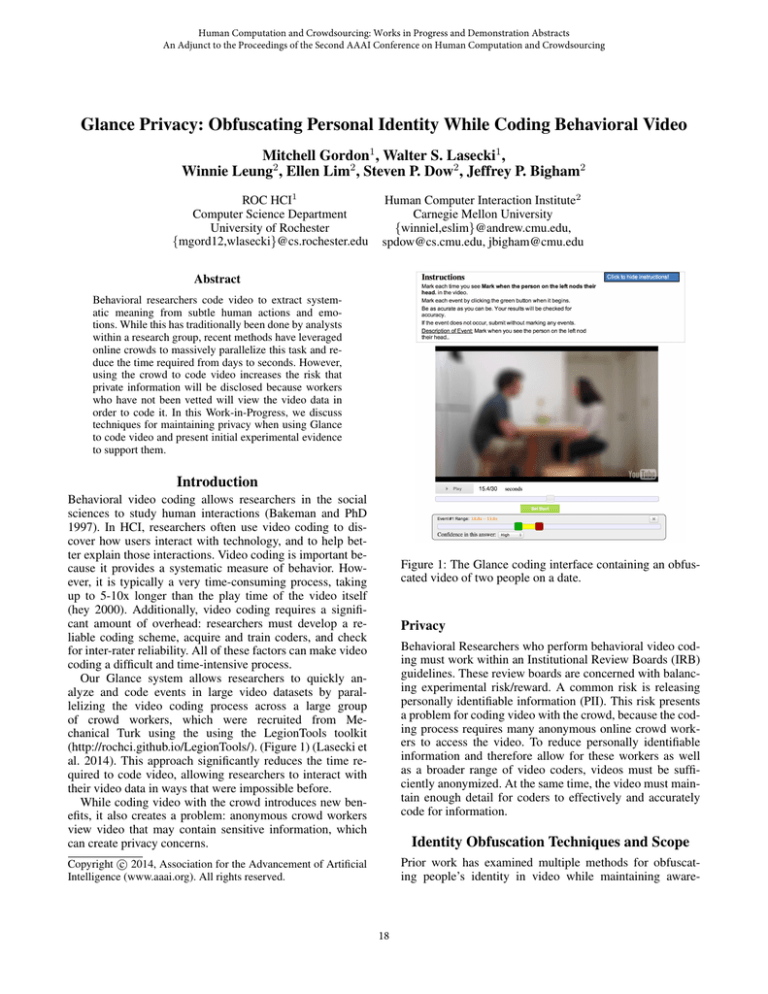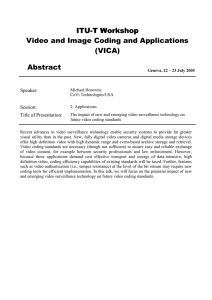Glance Privacy: Obfuscating Personal Identity While Coding Behavioral Video Mitchell Gordon ,
advertisement

Human Computation and Crowdsourcing: Works in Progress and Demonstration Abstracts
An Adjunct to the Proceedings of the Second AAAI Conference on Human Computation and Crowdsourcing
Glance Privacy: Obfuscating Personal Identity While Coding Behavioral Video
Mitchell Gordon1 , Walter S. Lasecki1 ,
Winnie Leung2 , Ellen Lim2 , Steven P. Dow2 , Jeffrey P. Bigham2
ROC HCI1
Computer Science Department
University of Rochester
{mgord12,wlasecki}@cs.rochester.edu
Human Computer Interaction Institute2
Carnegie Mellon University
{winniel,eslim}@andrew.cmu.edu,
spdow@cs.cmu.edu, jbigham@cmu.edu
Abstract
Behavioral researchers code video to extract systematic meaning from subtle human actions and emotions. While this has traditionally been done by analysts
within a research group, recent methods have leveraged
online crowds to massively parallelize this task and reduce the time required from days to seconds. However,
using the crowd to code video increases the risk that
private information will be disclosed because workers
who have not been vetted will view the video data in
order to code it. In this Work-in-Progress, we discuss
techniques for maintaining privacy when using Glance
to code video and present initial experimental evidence
to support them.
Introduction
Behavioral video coding allows researchers in the social
sciences to study human interactions (Bakeman and PhD
1997). In HCI, researchers often use video coding to discover how users interact with technology, and to help better explain those interactions. Video coding is important because it provides a systematic measure of behavior. However, it is typically a very time-consuming process, taking
up to 5-10x longer than the play time of the video itself
(hey 2000). Additionally, video coding requires a significant amount of overhead: researchers must develop a reliable coding scheme, acquire and train coders, and check
for inter-rater reliability. All of these factors can make video
coding a difficult and time-intensive process.
Our Glance system allows researchers to quickly analyze and code events in large video datasets by parallelizing the video coding process across a large group
of crowd workers, which were recruited from Mechanical Turk using the using the LegionTools toolkit
(http://rochci.github.io/LegionTools/). (Figure 1) (Lasecki et
al. 2014). This approach significantly reduces the time required to code video, allowing researchers to interact with
their video data in ways that were impossible before.
While coding video with the crowd introduces new benefits, it also creates a problem: anonymous crowd workers
view video that may contain sensitive information, which
can create privacy concerns.
Figure 1: The Glance coding interface containing an obfuscated video of two people on a date.
Privacy
Behavioral Researchers who perform behavioral video coding must work within an Institutional Review Boards (IRB)
guidelines. These review boards are concerned with balancing experimental risk/reward. A common risk is releasing
personally identifiable information (PII). This risk presents
a problem for coding video with the crowd, because the coding process requires many anonymous online crowd workers to access the video. To reduce personally identifiable
information and therefore allow for these workers as well
as a broader range of video coders, videos must be sufficiently anonymized. At the same time, the video must maintain enough detail for coders to effectively and accurately
code for information.
Identity Obfuscation Techniques and Scope
Prior work has examined multiple methods for obfuscating people’s identity in video while maintaining aware-
c 2014, Association for the Advancement of Artificial
Copyright Intelligence (www.aaai.org). All rights reserved.
18
ness of actions, such as applying a blur or pixelation filter.
Boyle discusses how blurring proved to be more effective
at obscuring identity than pixelation (Boyle, Edwards, and
Greenberg 2000). Additionally, Boyle presents 10 different
levels of filtering, representing a spectrum of magnitudes for
which the effect can be applied. In our initial experiments,
we chose to replicate Boyle’s blur filter and the exact increments of magnitude for each level.
Crowd workers might be able to determine identity in
video based off a number of factors, including facial recognition, clothing, voice, and environment. Additionally, video
can be shot and recorded in a variety of conditions that
present challenges to a ”one solution fits all” approach, such
as resolution, angle (front-on, side, etc.), zoom, contrast, and
number of people present in the video. For a feasible initial
experiment, we chose to focus on just facial recognition in
ideal lighting conditions and high video resolution.
Figure 2: Workers are shown a police-lineup style tool, allowing us to determine whether they can identify a person
they just saw in the previous video. The image above the
lineup was from the blurred video (note that workers are not
shown this image when they perform the task).
We first coded the original, unblurred video (level 10 on
Boyle’s scale). The crowd coded this accurately, with a precision of .942 and recall of .016. We then coded the same
video, but blurred with a level 6 filter and the crowd was
very nearly as accurate, with a precision of .939 and recall
of .017.
While the coding was similar, the lineup identification results showed that ability to identify participants was not. For
the unblurred video, 29 of 43 workers were able to correctly
identity the participant, whereas for the blurred video at level
6, just 6 of 35 workers identified the participant. This shows
that, by using a blur filter at an optimal level, the crowd is
able to code the video accurately without significantly compromising the identity of participants.
Preliminary Experiments
To evaluate how effective blurring is at hiding identity in
video while maintaining awareness of actions, we ran a feasibility study. We used Glance to code a video at different
levels of blurriness. The video contained a constant, sideways shot of two people on a date, and workers coded for
instances of when the person on the left nodded their head
(Figure 1). Head nodding was chosen for this preliminary
experiment because it is a subtle enough action that blurring a video too much could make it impossible to code for,
while it is not so subtle that a mild blurring would prevent
its identification. When blurring the video, we chose a blur
magnitude level of 6 on Boyle’s scale. We believe that this
level is just before the “threshold” for the maximum amount
of blur that can be applied to the video before coding for
head-nodding and other similar actions in our date video becomes inaccurate.
Future Work
Our preliminary experiments have just begun to explore how
we can effectively obfuscate identity in video while maintaining awareness of actions. Future work will significantly
expand our evaluation to a full study that includes:
Lineup Tool
• Video from psychology researchers.
To determine whether workers can identify a person after
watching a video containing that person, we built a policelineup style identification tool that displayed images horizontally (Figure 2). We required workers to answer whether
the recognized the person in each image from the video they
just watched. We first asked workers to code the date video
for head-nodding, and then immediately directed them to
this lineup tool, which contained one image of a person from
the video they just watched (not a screenshot from the video,
but a separate picture entirely), mixed in with 5 other images of different people with similar appearances. These six
images were displayed in a random order to each worker.
We did not give workers any warning or indication that they
would be completing the lineup tool after coding a video.
• Video that spans multiple variables, such as differing levels of zoom, resolution, contrast, and number of people in
the video, as discussed in the Identity Obfuscation Techniques and Scope section.
• Evaluating how well the crowd can identify people when
it is warned in advance that it will need to do so.
• Using the fact that we have multiple workers to identify
parts of actions that are hidden with just one type of filter.
References
Bakeman, R., and PhD, J. M. G. 1997. Observing Interaction:
An Introduction to Sequential Analysis. Cambridge University
Press.
Boyle, M.; Edwards, C.; and Greenberg, S. 2000. The effects
of filtered video on awareness and privacy. In CSCW, CSCW
’00, 1–10. New York, NY, USA: ACM.
2000. Handbook of Research Methods in Social and Personality
Psychology. Cambridge University Press.
Lasecki, W. S.; Gordon, M.; Koutra, D.; Jung, M.; Dow, S. P.;
and Bigham, J. P. 2014. Glance: Rapidly coding behavioral
Results
We ran our experiment on Amazon Mechanical Turk and received 120 worker responses. The crowd coded 10 minutes
of our date video, split into twenty 30-second segments, at
blur levels of 6 and 10 (unblurred) as a baseline. Each segment was coded redundantly by three unique workers.
19


